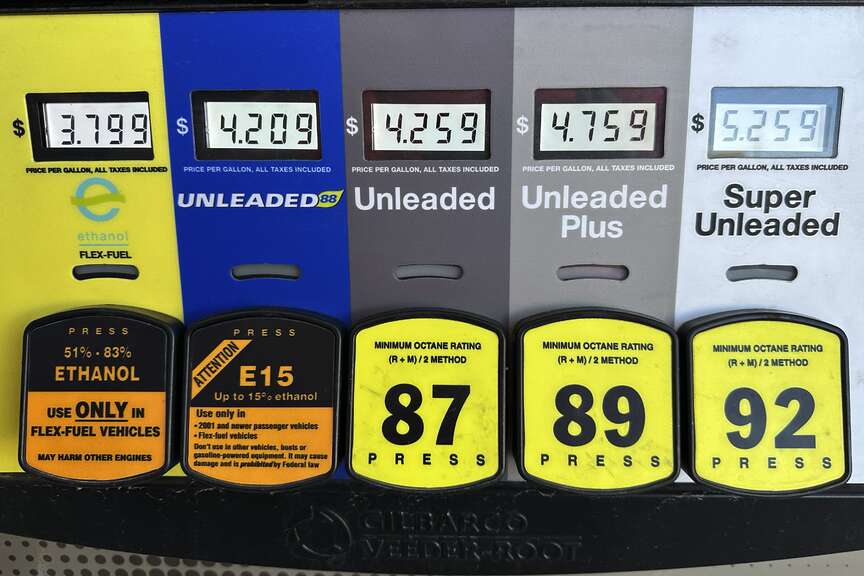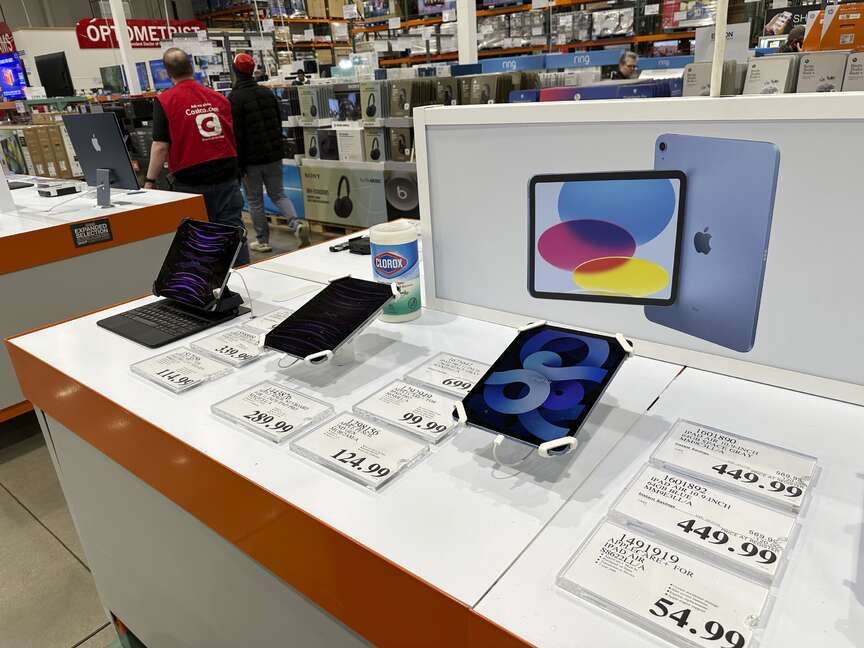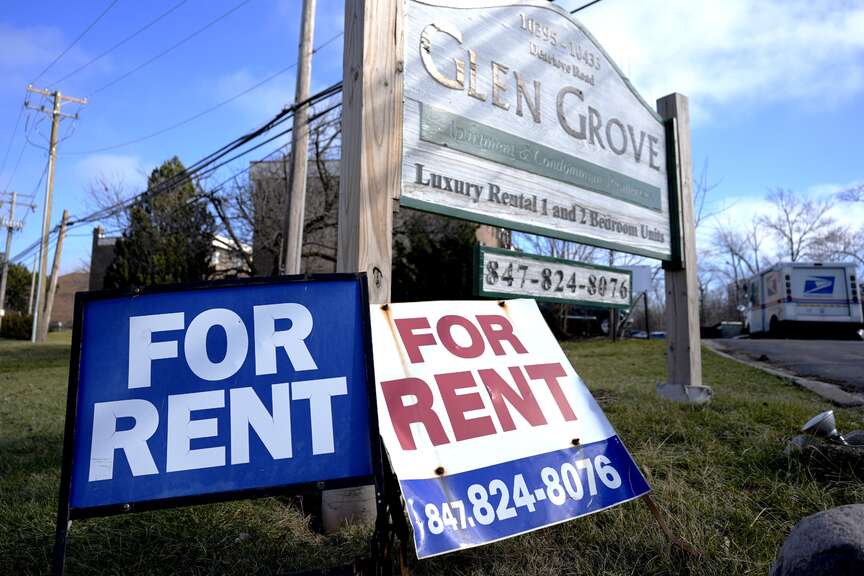WASHINGTON -- Consumer inflation remained persistently high last month, driven by rising prices for gasoline, rent, auto insurance and other items, the government said Wednesday.
Prices outside the volatile food and energy categories rose 0.4% from February to March, the same accelerated pace as in the previous month. Measured from a year earlier, these core prices are up 3.8%, unchanged from the year-over-year rise in February. The Fed closely tracks core prices because they tend to provide a good read of where inflation is headed.
Analysts said the report will likely give pause to the Federal Reserve as it considers how often -- or even whether -- to cut interest rates this year.
"This marks the third consecutive strong reading and means that the stalled disinflationary narrative can no longer be called a blip," said Seema Shah, chief global strategist at Principal Asset Management.
"In fact, even if inflation were to cool next month to a more comfortable reading, there is likely sufficient caution within the Fed now to mean that a July cut may also be a stretch, by which point the U.S. election will begin to intrude with Fed decision making," she said.
The March figures, well above the Fed's 2% target, provide concerning evidence that inflation is stuck at an elevated level after having steadily dropped in the second half of 2023. The latest numbers threaten to torpedo the prospect of multiple rate cuts this year. Fed officials have made clear that with the economy healthy, they're in no rush to cut their benchmark rate despite their earlier projections that they would do so three times this year.
The report "pours cold water on the view that the faster readings in January and February simply represented the start of new-year price increases that were not likely to persist," Kathy Bostjancic, chief economist at Nationwide, said in a research note. "The lack of moderation in inflation will undermine Fed officials' confidence that inflation is on a sustainable course back to 2% and likely delays rate cuts to September at the earliest and could push off rate reductions to next year."
On Wall Street, traders sent stock prices tumbling and bond yields rising, reflecting fear that the Fed may delay interest rate cuts indefinitely. The S&P 500 dropped 0.9%, the Dow Jones Industrial Average tumbled 422 points, or 1.1%, and the Nasdaq composite fell 0.8%.
Chair Jerome Powell has stressed that the Fed's policymakers need more confidence that inflation is steadily slowing to their target level before they will support a rate cut. Lower rates could fuel faster growth and potentially push inflation higher. Powell's stance has elevated the profile of the monthly inflation data in determining when the Fed might start cutting rates. Lower rates would lead, over time, to reduced borrowing costs for businesses and consumers.
Some Federal Reserve policymakers argued at their most recent meeting in March that inflation was likely worsening.
According to the minutes of the Fed's March 19-20 meeting released Wednesday, all 19 Fed officials generally agreed that high inflation readings in January and February "had not increased their confidence" that inflation was falling steadily to their 2% target. The leveling-off of inflation makes it less likely that the Fed will implement the three quarter-point rate cuts that the officials had projected after their March meeting.
The Fed "is nowhere near where they're going to need to be," said Douglas Holtz-Eakin, president of the American Action Forum and former director of the Congressional Budget Office. "March would not give anyone any confidence."
Overall consumer prices rose 0.4% from February to March, the same as in the previous month. Compared with a year ago, prices rose 3.5%, up from a year-over-year figure of 3.2% in February.
The Fed closely tracks a separate inflation gauge that has been coming in below the consumer price index, released Wednesday. Yet those figures will likely come in high enough to concern policymakers.
The inflation report is a disappointment for the White House. Republican critics of President Joe Biden have sough to pin the blame for high prices on the president and use it as a cudgel to derail his re-election bid. Polls show that despite a healthy job market, a near-record-high stock market and a decline inflation from its peak, many Americans blame Biden for high prices.
The persistence of elevated U.S. inflation complicates Biden's claims to be making steady progress against higher prices. The president has argued that further improvement would be possible if Republicans in Congress would back his policies.
"My agenda is lowering costs for prescription drugs, health care, student debt and hidden junk fees," Biden said in a statement.
The costs of owning a vehicle were a key reason why prices jumped last month: Auto insurance surged 2.6% in March and are up a dramatic 22% from a year ago. That increase reflects, in part, the rise in new-car prices over the past two years.
Average auto repair costs increased 1.7% from February to March and are up a sharp 8.2% from a year earlier. And the price of gas to power most vehicles surged 1.7% last month. Prices for new and used cars, though, fell slightly.
Clothing costs jumped 0.7% in March, the second straight month of sizable increases, though they have barely risen over the past year. Grocery prices, though, were unchanged last month and are just 1.2% higher than they were a year ago, providing some relief to consumers after the huge spikes in food prices in the previous two years.
The chronically elevated inflation so far this year does suggest that American consumers, on average, remain confident enough to keep spending despite steady price increases, said Laura Rosner-Warburton, senior economist at MacroPolicy Perspectives, a consulting firm. Likewise, she said, the surge in auto insurance and repair costs reflect the previous sharp increases in auto sales prices.
"It means that the consumer's in good shape and accepting price increases still," Rosner-Warburton said.
Though inflation has plummeted from its peak of 9.1% in June 2022, average prices are still well above where they were before the pandemic. This has meant hardships for many lower-income families, whose wages may not have fully kept up with rising prices.
Derrick Chubbs, president of the Second Harvest Food Bank of Central Florida, said his organization is providing 300,000 meals a day, even more than the 250,000 it supplied in November 2022. The people his organization serves, he said, increasingly include homeowners. And most of them are employed.
Chubbs said the beneficiaries typically live paycheck-to-paycheck and are vulnerable to any sharp change in their financial circumstances. Most are still struggling to recover from the jump in costs over the past three years, including in rents, child care and car ownership -- practically a necessity in a region with limited public transportation.
"If anything throws them off, it's going to take them a while to recover," Chubbs said. "Just because things get better, that doesn't mean that I've caught up with everything."
Information for this article was contributed by Christopher Rugaber and Josh Boak of The Associated Press, Steve Matthews of Bloomberg News (WPNS) and Rachel Siegel of The Washington Post.




